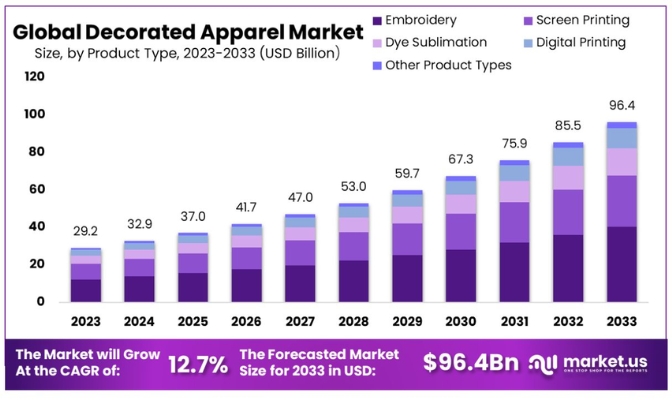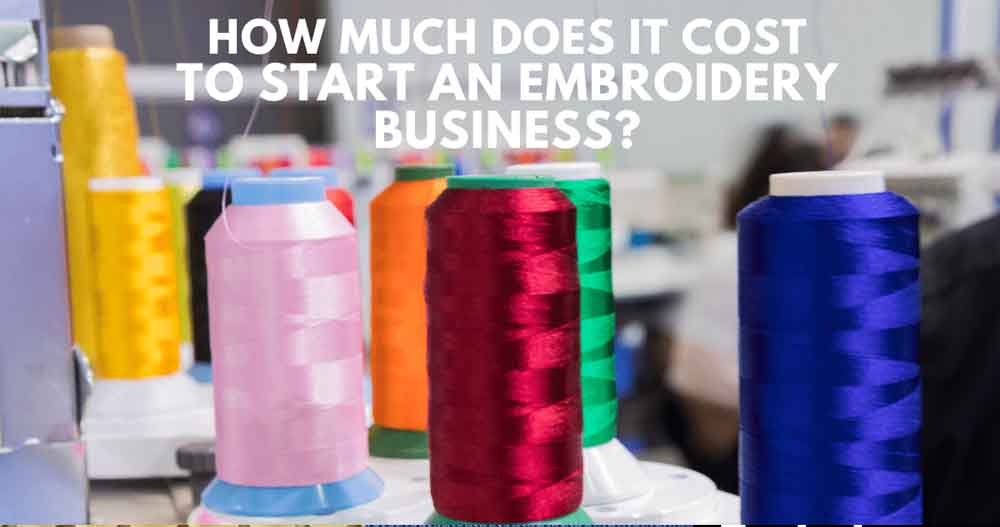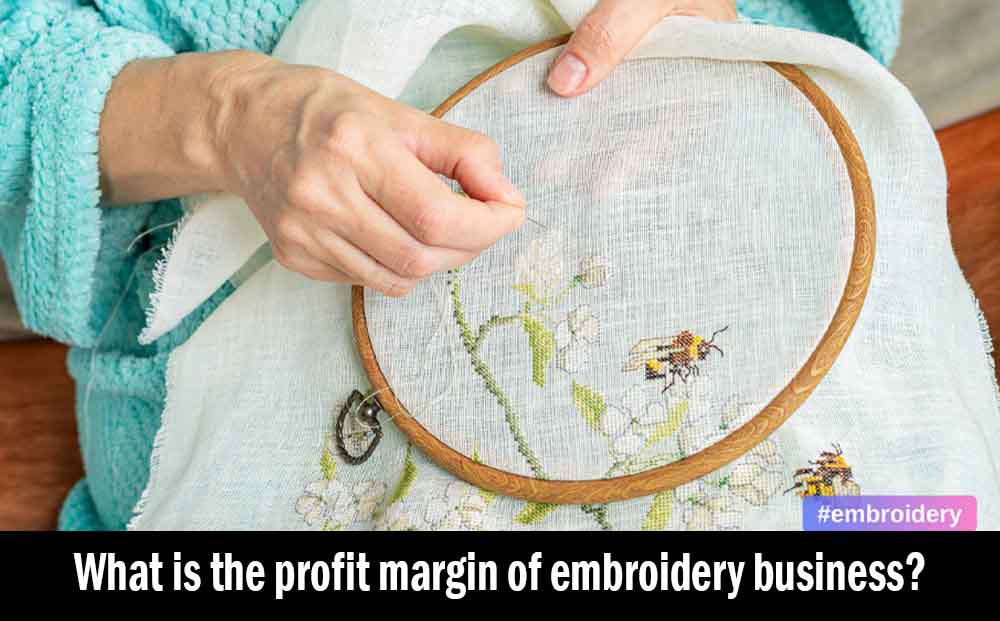What is The Embroidery Business Profit Margin in The United States?
The embroidery business in the US has been growing steadily, and it’s now worth $5.2 billion. This shows that there’s a high demand for personalized clothing and home goods.
In the future, the embroidery market is expected to keep growing because people are looking for unique and eco-friendly products, and technology is becoming more widely used. By 2030, the global embroidery market is predicted to reach multi-million figures, with a surprisingly high annual growth rate compared to 2023.
The potential for entering this market is still huge, but it is also very competitive and if you cannot stand out and attract customers, it will be very difficult for you to survive. This article will show you what the embroidery business’s profit potential is and what you can do to maximize your profitability.

By examining revenue sources, calculating profit margins, and studying successful case studies, business owners can gain insights into the financial aspects of running an embroidery business.
1. How much does it cost to start an embroidery business
Beginning an embroidery business can be an exciting venture, but it demands a considerable investment of time, effort, and money as well. The initial costs of starting an embroidery business can vary greatly, depending on factors like the size of the business, location, equipment, and marketing efforts. Here are some key expenses that you should be prepared for ahead of time.
1.1. Embroidery Machine
Embroidery machines, the heart of the business, come with a broad spectrum of prices. They range from $300 for basic, single-needle flatbed machines, suitable for simple monogramming projects, to over $20,000 for advanced multi-head machines designed for large-scale production. The choice between these types hinges on the scale and scope of your business. A common strategy is to start with a more affordable single-needle machine and scale up to multi-needle variants as the business grows and profits increase. It’s also worth considering the purchase of used machines or exploring financing options to ease initial financial burdens.
1.2. Supplies
The next significant expenditure is supplies, with a starting budget of around $125. Essential supplies include a variety of machine embroidery threads, different from standard sewing threads, and several types of embroidery stabilizers in various sizes. These stabilizers are vital for working on a wide range of blanks. Additionally, investing in extra machine hoops can be a wise decision, allowing for continuous project preparation and flexibility in choosing the most cost-effective hoop size for each project.
1.3. Embroidery Blanks
For embroidery blanks, a budget of $100 or more is a safe starting point. This category includes items like t-shirts, polos, blankets, and pre-made patch blanks. Entrepreneurs must strike a balance between offering a diverse product range to attract a broader customer base and the initial investment in stocking these blanks.
1.4. Business Formation
The cost of forming a business varies widely, starting from zero to over $300. This depends on whether you choose to operate informally or form a more official business structure like an LLC, which involves varying filing costs across different states.
1.5. Physical Location Rent
While starting from home is cost-effective, expansion may necessitate renting a dedicated space. This move brings additional expenses like rent, utilities, and insurance.
1.6. Marketing and Promotion Expenditures
Marketing and promotion are critical in making your business known, with costs ranging from free to over $1,000. Key strategies are key to building an online presence, using social media platforms, and even investing in online advertising. Traditional marketing methods like road signs, mailers, and local ads can be equally important for physical stores.
1.7. Cost of Designs and Digitizing Software
The design aspect involves costs that can range from free to upwards of $1,000. While most embroidery machines come with built-in designs, additional custom designs may need to be purchased or created. Creating custom designs necessitates digitizing software, which can be expensive. However, there are free software options available, albeit with limited capabilities.
1.8. Computer Investment
A computer with a USB port or WiFi is essential, especially if you plan to purchase designs and need to transfer them to your embroidery machine. If opting for digitizing software, a computer with above-average specifications will be required to handle the software efficiently. Beginning an embroidery business can be an exciting venture, but it demands a considerable investment of time, effort, and money as well. The initial costs of starting an embroidery business can vary greatly, depending on factors like the size of the business, location, equipment, and marketing efforts. Here are some key expenses that you should be prepared for ahead of time.
Overall, the starting cost to start an embroidery business can range from $10,000 – $30,000 or more, depending on your business model, location and equipment.

2. Potential sources of income from embroidery business
One way to estimate the potential income of an embroidery business is by looking at the revenue generated from completed orders. For instance, a small embroidery business with one embroidery machine and two employees can expect to earn around $20,000 to $30,000 per year on average. On the other hand, a larger embroidery business with multiple machines and employees has the potential to earn up to between $200,000 to $500,000 annually or even more.
In addition to the main revenue stream of providing custom embroidery services, which includes embroidering logos, designs, and add text on various items such as clothing and hats, there are several other common revenue streams and potential sources of income for an embroidery business. These include:
- Wholesale and bulk orders: Embroidery businesses can generate additional income by serving wholesale and bulk order requests. This involves partnering with businesses, retailers, or organizations that require large quantities of embroidered products, such as uniforms, merchandise, or corporate gifts.
- Retail sales: Some embroidery businesses choose to directly sell pre-embroidered products to customers. This can include items like embroidered clothing, accessories, or home decor. Retail sales can be conducted through physical stores, online platforms, or a combination of both.
- Personalization services: Offering personalized services alongside embroidery can be a profitable income source. This can include monogramming, adding names or initials, or customizing designs based on individual customer preferences.
- Equipment and supplies sales: Embroidery businesses can generate income by selling embroidery machines, equipment, and supplies to other businesses or individuals looking to start their own embroidery ventures.
It is important for embroidery business owners to assess their target market, competition, and local demand to determine the most feasible revenue streams and sources of income for their specific business operations.

3. What is the embroidery business profit margin?
Profit margins can vary in the embroidery industry. On average, embroidery businesses in the US typically have a profit margin of around 15-20%. This shows that there is potential for profitability in the industry, and it’s important to effectively manage costs and pricing.
Another factor to consider is the type of business setup. Both home-based and storefront embroidery businesses can be successful and profitable. Home-based businesses often have lower overhead costs, which can lead to higher profit margins. On the other hand, storefront businesses benefit from increased visibility and the potential for walk-in customers.

4. Factors Influencing Embroidery Profitability
The profitability of an embroidery business can be influenced by various factors that impact its revenue and overall success. Understanding these factors is crucial for business owners to make informed decisions and maximize profitability. Factors that can influence embroidery profitability include:
4.1. Embroidery market demand and trends
The level of demand for custom embroidery services in the US market can significantly impact the revenue potential of an embroidery business. When starting an embroidery business, business owners need to pay a lot of attention to factors such as consumer preferences, trends and local competition – these factors greatly affect the demand for embroidery products.
When entering the embroidery business market, it is important to know what famous competitors are doing, for example, some famous tailor shops in each state such as:
- EmbroidMe – Florida
- Stitch America – Texas
- CustomInk – Virginia
- 4imprint – Wisconsin
- Queensboro Embroidery – North Carolina
- Vantage Apparel – New Jersey
Maybe when you sell an embroidery product that suits the market needs at that time, you may earn a lot. But when needs and trends change and you do not adapt promptly, the profits earned will decrease and your business gradually falls behind.
4.2. Competition and pricing strategies
Competitive strategy and pricing are important factors affecting the profitability of an embroidery business. When entering a competitive market, business owners need to consider how other businesses price their embroidery services and products.
Setting a price too high can discourage potential customers, while setting a price too low can lead to reduced profit margins. You should find the suitable balance to both appeal to customers and give you the desired profit margin.
4.3. Cost of everything
The cost of things is an important factor that affects the profitability of an embroidery business. Starting and running an embroidery business involves many different costs, including equipment, supplies, rent, utilities, marketing, and labor costs.
Without careful budgeting, cost analysis and finding cost-effective solutions, it will lead to overspending and impacting profit margins, and you will not have much capital left to make other necessary changes.
4.4. Labor and skill requirements
The quality and expertise of the workforce directly affects the efficiency and effectiveness of the embroidery process.
Skilled employees with experience in embroidery techniques can produce high-quality products in less time, increasing productivity and potentially reducing labor costs. On the other hand, inexperienced or untrained workers may need more time and resources to complete tasks, affecting profits.
If you designate a small business with a small number of employees, choosing inexperienced workers may save you some costs, but you will have to spend time training them.
4.5. Marketing and customer acquisition
In today’s modern world, customers will not be able to know who you are if you do not have measures to market and attract them.
An effective marketing strategy is essential to reach and attract potential customers. This can include online and offline advertising, social media promotion, attending trade shows and networking with relevant businesses. By investing in marketing efforts, businesses can increase brand awareness, attract new customers, and generate more revenue.
Additionally, building strong relationships with existing customers through excellent customer service and personalized experiences can lead to customer loyalty and repeat purchases.
5. Strategies for Maximizing Profitability
To maximize profits in the embroidery business, it is important to implement effective strategies. Including:
- Effective cost management and budgeting: Carefully tracking costs and finding ways to reduce costs can help improve profit margins. Estimated costs are listed above.
- Differentiated and value-added services: Offering unique and specialized embroidery services, as well as additional value-added services such as design consultation or customization, can attract customers and justify the higher price.
- Customer retention and repeat business: Building strong customer relationships through excellent service, personalized experiences, and loyalty programs can encourage repeat business and generate positive word-of-mouth referrals.
- Leverage technology and automation: Leveraging technological advances and automation tools can streamline processes, increase productivity and reduce labor costs, ultimately increasing profits.
6. Embroidery Market Opportunities and Growth Potential
The global embroidery market size is valued at USD 2729.09 million by 2022 and is expected to expand at a CAGR of 13.11% during the forecast period, reaching USD 5715.94 million by 2028.
This shows that the embroidery market is still a fertile market for entrepreneurs who want to enter. However, it doesn’t matter what product you like to sell. You need to find out which niche market has few competitors and is in high demand and consider joining that niche market.
One more thing, you don’t only compete at “physical stores”, but you also need to expand your business to online platforms such as Facebook, Instagram, X and e-commerce platforms (Amazon, etc.). This way, customers will easily know your store and it will be convenient for customers who live far away. And if you do the marketing stuff well, there will be no limit to your profits.

7. Price Your Embroidered Products
Competitive pricing attracts customers while ensuring you maintain a healthy profit margin. Here are some key factors to keep in mind when pricing your embroidery services:
- Understand your costs: Calculate the total costs involved, including materials, labor, equipment depreciation, and overheads. Knowing these costs will help you set a base price that covers your expenses.
- Research market rates: Investigate how similar businesses price their services. This will give you a benchmark and help you position your products competitively.
- Consider your target audience: High-end designs might command higher prices, while more accessible designs could attract a broader market.
- Include profit margins: Aim for profit margins in the 20% to 50% range to ensure long-term sustainability and growth.
8. Top 10 Ideas for Making Money with Embroidery
Embroidery provides endless opportunities for creating profitable products. Here are ten of the most lucrative options:
- Caps and Hats: Embroidered caps and hats are consistently popular for sports teams, businesses, and promotional events. Offering creative or personalized designs helps boost demand, while low material costs and quick production with the right machine ensure strong profit margins.
- Tote Bags: Tote bags are both practical and stylish, especially when made from eco-friendly materials. Customizing them for events, businesses, or personal use can be highly profitable, particularly for small home-based embroidery businesses.
- Towels: From bath towels to kitchen towels, personalization adds value and makes them ideal as gifts or promotional items. Their large surface area allows for detailed embroidery, and sourcing them affordably makes bulk orders especially profitable.
- Bridal and Wedding Accessories: The wedding industry thrives on personalization. Embroidered robes, handkerchiefs, and bridal party gifts carry sentimental value and can be sold at premium prices.
- Athletic Wear: Custom jerseys, tracksuits, and hats are in high demand among sports teams and fitness enthusiasts. Adding logos, names, or team designs can secure repeat orders and establish long-term partnerships with local clubs.
- Baby and Children’s Clothing: Parents and relatives love embroidered baby blankets, bibs, and outfits. This ever-growing market supports higher pricing for personalized, high-quality items.
- Home Decor: Embroidered pillows, throws, and wall hangings are trending in home design. They can be customized to suit various styles or serve as personalized gifts, making them a profitable segment.
- Corporate Branding Items: Uniforms, T-shirts, and caps embroidered with company logos are a staple for businesses. This niche often brings large, repeat orders, making it one of the most reliable revenue streams.
- Pet Accessories: The booming pet industry creates strong demand for embroidered collars, leashes, and blankets. Personalized products with pet names or designs are especially popular, offering great profit potential.
- Monogrammed Gifts: Towels, linens, and bags with embroidered monograms are timeless favorites. Demand peaks around weddings and holidays, making this category perfect for high-volume sales.

9. How to Grow Your Embroidery Business
Now that you know how to start an embroidery business, it’s time to learn how to grow and expand it while maintaining your competitiveness in the market.
9.1. Stay updated on embroidery industry trends
Monitor social media platforms like Instagram, Facebook, and Pinterest for design inspirations and innovative techniques. Keep an eye on emerging markets and evolving customer preferences to refine your offerings.
Stay informed about new tools and software developments that can streamline your operations. By embracing these trends, you’ll meet customer expectations and set your business apart from competitors.
9.2. Invest in upgraded embroidery machines
Advanced models, especially multi-needle options, streamline workflow and enhance productivity. They offer precision and speed, allowing you to fulfill orders more efficiently. Modern machines are also equipped with sophisticated software that can elevate the quality of your designs.
Always research different brands and models to find one that fits your business needs perfectly, ensuring a smart, long-term investment in your success.
9.3. Diversify your product offerings
While embroidered t-shirts and hats remain popular, consider venturing into less saturated items like personalized tote bags, custom home décor, or unique apparel for niche events.
Offering a diverse selection highlights your creativity and meets various customer needs. Carefully chosen products aligned with your niche can boost brand loyalty and enhance your presence in the competitive embroidery landscape.
9.4. Expand your marketing efforts
Develop engaging content that highlights the uniqueness of your embroidered products. Utilize SEO strategies to improve your website’s visibility, and consider investing in paid advertising for targeted outreach. Attend local craft fairs or farmers markets to connect with potential customers face-to-face.
Branding is key—ensure your logo and marketing materials consistently reflect your business identity and leave a lasting impression.
9.5. Build relationships with local businesses
By collaborating with small businesses, wedding planners, and corporate clients, you can establish a network that brings steady referrals.
Consider offering custom designs tailored to local sports teams or businesses, too. This personal touch not only boosts sales but also builds community ties. Regularly attend networking events and maintain good relationships with partners to ensure lasting, trust-based collaborations.

10. FAQs
Some questions about embroidery business profit margin:
10.1. How much does it cost to start an embroidery business?
The startup cost for an embroidery business typically ranges from $3,000 to $15,000, depending on machine quality and material selection. A small home setup with basic equipment may begin at just $400, while high-end professional machines can push costs up to $20,000. Careful budgeting is key to matching your investment with your business goals.
10.2. Is embroidery a good business
Yes. With strong demand for custom designs and textiles, embroidery can be very profitable. When managed efficiently, it offers an excellent return on investment. Using platforms like Gelato, cutting overhead costs, and applying smart pricing strategies can help you scale and succeed in this creative field.
10.3. Is starting a home embroidery business worth it?
Absolutely. A home embroidery business requires relatively low startup costs and allows you to work with flexibility and creativity. The growing demand for personalized products makes it an attractive, low-risk venture for aspiring entrepreneurs.
In brief, starting an embroidery business can make lots of money for people who want to invest because it doesn’t cost much to begin with and lots of people want personalized products. But, to make the most money and handle challenges like competition, technology, staffing, and marketing, it’s crucial to have a good plan, focus on quality work, offer fair prices, spend on effective advertising, and provide exceptional customer service.
Before starting any business, the first thing to find out is whether that business will help you make money or not. And there are many partners who have come to K-Embroidery for advice, because they know that K-Embroidery is a factory that also started from a small factory and gradually developed into a leading reputable manufacturer of smocking children’s clothing in Vietnam.
Contact K-Embroidery manager to buy high quality, cute and safe hand-sewn products for children via WhatsApp: +84855 555 961 to get the best price and order now!
Contact:
- Address: 5th Floor, Building No. 169 Nguyen Ngoc Vu, Cau Giay District, Hanoi
- Hotline: +84855 555 961
- Website: https://k-embroidery.com/
- WhatsApp: +84855 555 961


